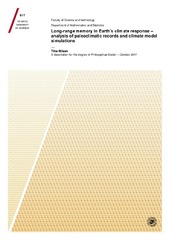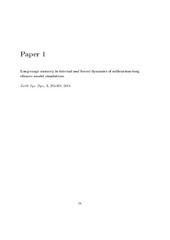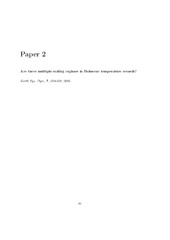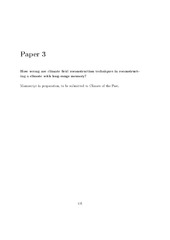| dc.contributor.advisor | Rypdal, Kristoffer | |
| dc.contributor.author | Nilsen, Tine | |
| dc.date.accessioned | 2018-02-20T14:24:09Z | |
| dc.date.available | 2018-02-20T14:24:09Z | |
| dc.date.issued | 2018-01-22 | |
| dc.description.abstract | The memory properties in paleoclimate temperature records based on model simulations and proxy-reconstructions have been investigated, to find out if these records exhibit long-range memory in a similar manner as many instrumental temperature records. On time scales from years to centuries and even millennia, long-range memory is identified in the paleoclimate records using a toolbox of statistical time series analysis techniques. However, extra care must be taken when making inference about the memory in proxy-based temperature reconstructions. These records are subject to noise, uncertainties and biases that are not relevant to instrumental temperature. | en_US |
| dc.description.doctoraltype | ph.d. | en_US |
| dc.description.popularabstract | Simplified statistical models of the natural variability of Earth’s surface temperature are tested using paleoclimate records based on model simulations and indirect temperature estimates from the past. A property known as long-range memory is assumed to represent the internal variability of the climate on time scales from years to centuries. This property reflects the inertia in the climate system, and is relevant for modelling past, present and future climate change. Statistical analysis of reconstructed temperature is performed using spectral methods, wavelet-based methods and other time series analysis tools. The results show that temperature from the past apparently exhibit long-range memory on the time scales under study. However, the influence from non-climatic effects such as noise and reconstruction methodologies on the signal makes the interpretation of the memory less intuitive than it is for instrumental temperature records. | en_US |
| dc.description.sponsorship | The position has been funded by the Norwegian Research Council, the KLIMAFORSK programme, under grant number 229754.
Additional financing has been received from Tromsø Research Foundation via the UiT project A31054. | en_US |
| dc.identifier.isbn | 978-82-8236-284-9 (trykt) og 978-82-8236-285-6 (pdf) | |
| dc.identifier.uri | https://hdl.handle.net/10037/12199 | |
| dc.language.iso | eng | en_US |
| dc.publisher | UiT Norges arktiske universitet | en_US |
| dc.publisher | UiT The Arctic University of Norway | en_US |
| dc.rights.accessRights | openAccess | en_US |
| dc.rights.holder | Copyright 2018 The Author(s) | |
| dc.rights.uri | https://creativecommons.org/licenses/by-nc-sa/3.0 | en_US |
| dc.rights | Attribution-NonCommercial-ShareAlike 3.0 Unported (CC BY-NC-SA 3.0) | en_US |
| dc.subject | VDP::Mathematics and natural science: 400::Mathematics: 410::Applied mathematics: 413 | en_US |
| dc.subject | VDP::Matematikk og Naturvitenskap: 400::Matematikk: 410::Anvendt matematikk: 413 | en_US |
| dc.title | Long-range memory in Earth's climate response - analysis of paleoclimatic records and climate model simulations | en_US |
| dc.type | Doctoral thesis | en_US |
| dc.type | Doktorgradsavhandling | en_US |


 English
English norsk
norsk



